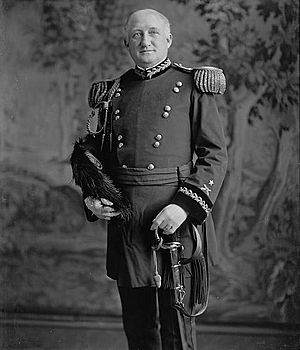Erasmus M. Weaver Jr. facts for kids
Quick facts for kids
Erasmus Morgan Weaver Jr.
|
|
|---|---|
 |
|
| Born | May 23, 1854 Lafayette, Indiana, US |
| Died | November 13, 1920 (aged 66) Washington, D.C., US |
| Place of burial | |
| Service/ |
United States Army |
| Years of service | 1875–1918 |
| Rank | Major general |
| Commands held | Chief of the Militia Bureau U.S. Army Coast Artillery Corps |
| Battles/wars | Spanish–American War World War I |
Erasmus Morgan Weaver Jr. (born May 23, 1854 – died November 13, 1920) was an important leader in the United States Army. He became a major general, which is a very high rank. He was the first person to lead the Militia Bureau and also led the Army's Coast Artillery Corps.
Contents
Early Life and Military Start
Erasmus Morgan Weaver Jr. was born in Lafayette, Indiana, on May 23, 1854. His father, Erasmus M. Weaver, was a well-known businessman. Young Erasmus went to the United States Military Academy, also known as West Point. He graduated in 1875. After graduating, he became a second lieutenant in the Artillery.
Teaching and Learning
Weaver had several interesting jobs early in his career. From 1883 to 1885, he taught military science. He taught at Western Reserve University and The Citadel. Later, from 1888 to 1891, he taught chemistry and electricity at West Point. He also continued his own education. From 1895 to 1896, he studied at the Massachusetts Institute of Technology.
Service in Wars
Weaver played a part in two major conflicts. These were the Spanish–American War and World War I.
Spanish-American War Role
In 1898, during the Spanish–American War, Weaver took on a new role. He was made a temporary lieutenant colonel. He joined the 5th Massachusetts Infantry, a group of volunteer soldiers. He first helped gather and organize the soldiers. Later, he led the 1st Battalion of this regiment.
Leading the National Guard
From 1908 to 1911, Weaver became the first head of the Army's Militia Bureau. This was a very important job. In this role, he was in charge of making sure the National Guard was well-trained and ready. The National Guard is a group of part-time soldiers who can be called upon in emergencies.
Leading the Coast Artillery
Weaver then became the Chief of the Coast Artillery Corps. He held this position from 1911 until he retired in 1918. The Coast Artillery Corps protected America's coastlines. He was promoted to brigadier general in 1911. In 1916, he became a Major General.
World War I Contributions
From 1917 until his retirement, Weaver also served on the War Council. This council was created by the War Department. Its job was to plan and oversee America's efforts in World War I.
Later Life and Legacy
Erasmus Morgan Weaver Jr. passed away in Washington, D.C., on November 13, 1920. He is buried at Arlington National Cemetery. This is a special cemetery for military heroes.
General Weaver's son, Walter Reed Weaver, also became a Major General. This shows a family tradition of military service. Two places in Hawaii are named after him: Fort Weaver and Fort Weaver Road.

